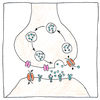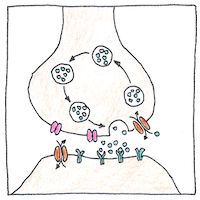Henry Hallett Dale, George Barger, Otto Loewi
neuroscience

|
Neurotransmitters
Knowing that the ergot fungi slows uterine contractions in premature labor, and interested in physiologically active chemicals, Dale and Barger isolated acetylcholine from ergot and demonstrated that it causes effects similar to the stimuli from the parasympathetic nerves that control blood pressure and sweating. This work established acetylcholine as a possible neurotransmitter. Debate had been raging whether nerves communicated electrically or chemically. Loewi did the experiment that proved that a chemical, later shown to be acetylcholine, transmitted from the vagus nerve of one frog’s heart, where it slowed the heart’s beating, could be transferred to the heart of another frog to slow the second heart’s beating. Over one hundred chemical neurotransmitters have been identified, although scientists have not identified all neurotransmitters nor determined their purposes.
Systems
Your noradrenaline system regulates arousal and reward, keeps you attentive, helps you feel the effects are worth the effort. What shall we say about your dopamine system? It governs your motor system and your motivation. Too little and you might have Parkinson’s disease; too much and you might be schizophrenic. Cocaine keeps dopamine in your receiving neurons longer. What does your serotonin system not relate to? It regulates your ability to feel pain. It regulates your appetite, your sleep, your mood, your temperature, your cardiovascular system, and the secretions of your glands. Prozac enhances the effects of natural serotonin. Finally, your cholinergic system regulates your memory and your ability to learn. Do you remember what you just read? If so, no doubt the neurotransmitter acetylcholine has been doing something in your head.
One pill makes you larger
Some neurotransmitters are excitatory and some are inhibitory. All neurotransmitters are targets for the drug industry. Chemicals alter your body; chemicals alter your mind. I write this not to establish a principle that all chemicals are the same, but to warn that any drug you take will be mixed into the broth of a finely seasoned stew in which simmer exotic vegetables and meats from plants and animals that science has not named. Sorry. That’s a bad metaphor. You are a vast work of fine art which, if damaged, only the most careful conservator would dare try to restore. You are a finely woven magic carpet of rare fibers, many colored, intricate of design. No other carpet is exactly like you. Your irregular pattern is impossible to trace, but something in its indescribable pattern makes it fly. You are a long and complex tale, a fable that exists in only the story-teller’s mind, so that to interrupt him would be to risk his forgetting how all the loose ends are supposed to resolve. You are actually a foreign land that has been only poorly mapped, whose people have strange customs and speak a strange language, but that has been invaded by gnats, snakes, moles, transister radios, poisonous vehicles, and gas warfare from the modern world. You are their representative; you must explain to them concepts that make no sense, and you must explain things from this odd land that we invariably do not understand. Some claim that any refined substance, like sugar, is a drug that can be both damaging and addictive. Yet you must eat, and you may choose to take aspirin for an ache, drink a glass of wine, or stress your body to experience a rush of adrenalin or an endomorphine high. These are not the same as experimenting with mind-altering mushrooms, but who’s to say? Who’s to judge? Whose body are we talking about but your inner temple! Your body is a chemistry laboratory, in which many oddly shaped test tubes and vials overflow with weirdly colored, pungent liquids that no one has labeled. Some vials have broken; smoke rises to the ceiling. Strange equipment, burners, filters, and mixers abound, but the laboratory manual has not been written, and you are here to conduct an experiment whose purpose has not been agreed to. Common table salt is essential for life, but eating too much can cause you great distress. Eating too much of anything would be too much. Even drinking too much water can kill you. You can buy a book that tells you what not to put up your nose, how much salt or water you should ingest, and why you should put it up your nose. I will not pretend to compete with the medicine men and global corporations, but I know that sometimes a shock can interrupt your negative patterns and awaken your creativity, and that, to add one last metaphor to this allegory, most clocks need to be reset once in a while.



In addition to chemical neurotransmitters, ions (such as zinc ions) and soluble gases (such as nitrogen monoxide) act as neurotransmitters, and gap junctions allow direct electrical communication between cells. In order to produce acetylcholine from the vagus nerve of the first frog’s heart, Otto Loewi electrically stimulated the nerve.
With the ergot fungi, we go full circle. Its medical uses and hallucigenic effects were well known in the Middle Ages. It contains both the first-known neurotransmitter and the alkaloid ergotamine, which is used to synthesize lysergic acid, an analog of and precursor for synthesis of lysergic acid diethylamide (LSD).
See also in The book of science:
Readings in wikipedia: